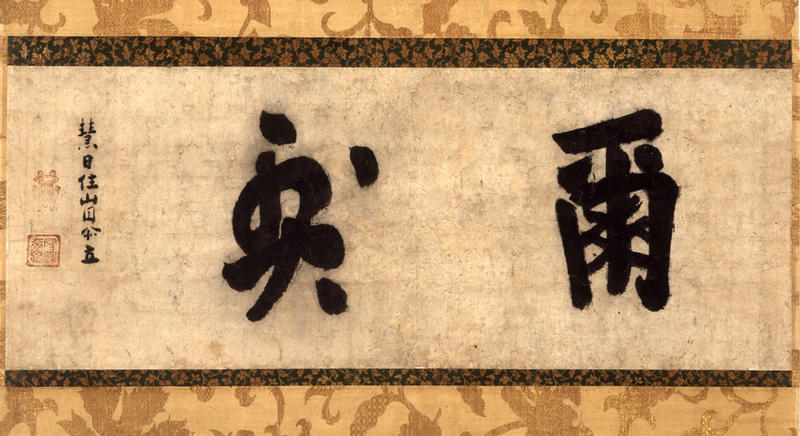東福円爾二字書 爾然
- 鎌倉時代
- 13c
- 紙本墨書
- H-33.4 W-87.2
東福寺開山・聖一国師円爾(1202~1280)が爾然の安名を与えたのは、三河の瑞境山実相寺3世の無外爾然と思われる。
爾然は京洛の出身で、円爾に参じた後、入宋、諸知識に歴参し帰朝した。円爾の臨終に際して「正法眼蔵、爾然に付属す」と円爾より遺嘱されてその法を嗣いだ。東福寺山内に正法院を開いて正法院派の派祖となり、普門寺の2世にもなっているが、東福寺の請(しょう)を9度も辞して終に住職とならず、文保2年(1318)11月12日、実相寺の方丈で示寂。正法院に塔され、応通禅師の勅謚(ちょくし)号を受けている。
世に道号の遺墨は多いが、この時代の安名の遺るものは少なく、わずかに嘉暦2年(1327)の年紀を有する清拙正澄筆の「霊肩」が知られる。しかし円爾が宋僧・無準師範(ぶしゅんしぱん)から与えられた安名(円爾)二幅は東福寺に現存し、重要文化財に指定されている。爾然の安名もその顰(ひそみ)に倣ったものであろうか。
円爾は駿河安倍郡藁科の出身。幼年にして久能山の尭弁について学び、その一字を受けて弁円と称した。承久元年(1219)、18歳、近江の園城寺で剃髪、東大寺で登壇授戒した。ついで上野(こうずけ)長樂寺の釈円房栄朝、寿福寺の大蠍了心らについて禅と天台を学んだが、嘉禎元年(1235)入宋、径山(きんざん)の無準(ぶしゅん)に参じて禅宗に転じた。その際無準より円爾と安名されるが、円爾はもともと教僧時代の房号(円爾房弁円)であり、転宗に際して房号を法諱に転用したのである。一般に円爾弁円と呼ばれているが、もともと円爾に道号はなく、禅宗転派以後の諱、円爾と、教僧時代の諱、弁円を並べ用いるのは誤りである。無準の印可を得て仁治2年(1241)帰国、随乗房湛慧に招かれて大宰府に崇福寺を、神子栄尊に招かれて肥前に水上山万寿寺を開創、翌仁治3年、豪商・謝国明に外護を得て博多に承天寺を開いて、化を鎮西に振った。寛元元年(1243)上洛して、九条道家の帰依を受けることになる。これより先、嘉禎2年(1236)頃より、道家は京都の東南、東山山麓に奈良の東大寺、興福寺より一字ずつをとって東福寺と名づける寺院建立の志があり、工事を始めていたので、早速円爾を東福寺開山に請じた。初めは教寺としての性格の強かった東福寺も、その開創に円爾が参画することによって、次第に禅を中心とする真言・天台兼修の道場としての形を整えていくことになる。
多年の歳月をかけて造営装厳された東福寺の大伽藍で、円爾が落慶・開堂の法要を行ったのは、道家発願の年より20年後の建長7年(1255)のことであり、道家没後3年目にあたった。円爾の示寂は弘安3年。世寿は79歳であった。
墨蹟(ぼくせき)
一般には墨筆で紙や絹に書いた筆跡のことをいいますが、特に日本では禅僧の書跡を指していいます。村田珠光が大徳寺の一休宗純に参禅して、印可の証明として授けられた圜悟克勤(えんごこくごん)の墨蹟を茶席に掛けて茶禅一味の境地を味わったのがはじまりで、以来宋元の禅僧の墨蹟が尊ばれるようになりました。千利休の頃からはさらに日本の臨済禅僧(虎関師錬など)の墨蹟も珍重され、特に大徳寺派の墨蹟(沢庵宗彭など)が重んじられました。
虎関師錬書 瑞巖道号并号頌
明恵上人書状
蘭渓道隆尺牘(東福円爾宛)
寂室元光法語
伝宗峰妙超一行書 達磨圓覚大師
道号(どうごう)
禅僧の名に諱(いみな)と号があり、号は知識や師匠から贈られるもの。宋代以降、字(あざな)と同義語になりましたが、本来は修行によって得た道や、その人の徳を表します。広く一般参禅者にも与えられました。
虎関師錬書 瑞巖道号并号頌
東福寺(とうふくじ)
京都市東山区にある臨済宗東福寺派の大本山。九条道家(くじょうみちいえ)が開基、円爾弁円(えんにべんねん)が開山。嘉禎2年(1236)に伽藍整備がはじまり35年の歳月を費やして文永8年(1271)に完成しました。三門は日本最古の山門(国宝)です。
蘭渓道隆尺牘(東福円爾宛)
安名(あんみょう)
新たに戒法を受けて出家、得度する者に法名をつけ与えること。またその法名を書したものをいう。
伝宗峰妙超一行書 達磨圓覚大師
Catalogue Entry
En'ni (1202-80)
En'ni, the founder of Tofukuji, is also known by the name Shoitsu Kokushi, and it is thought that he gave the name En'nito Mugai Jinen, the third generation head of Jissoji in Suikyozan of Mikawa.
Jinen was born in Kyoto, and after studying with En'ni, went to China where hestudied with some priest before returning to Japan. As he was dying, En'ni conferred his blessing upon Jinen with the name "Shoho Ganzo" and thus named him as his heir. Jinen went on to build the Shohoin within the grounds of Tofukuji, and become the head priest of the Shohoin branch. He also acted as the second generation head priest of Fumon temple.
While he acted nine times as the head priest of Tofukuji, he never became the head priest of Tofukuji. Jinen died on the 12th day of the 11th month of Bunpo 2 (1318) at Jissoji. His grave is at Shohoin and the posthumous name of Otsu Zenji was conferred upon him.
While a number of calligraphies of dogo Zen names remain today, there are very few examples of anmyo names from this period. Indeed, we have only "Reiken" brushed by Seisetsu Seicho and dated Kareki 2 (1327). However, two scrolls of the anmyo name "En'ni"conferred by the Song priest Wuzhun Shifan remain at Tofukuji, and both have been designated Important Cultural Properties. Might Jinen's anmyo name then follow this example set by his master?
En'ni was born in Warashina, Abe gun, Suruga (present-day Shizuoka Prefecture). As a child he studied with Gyoben of Kunoji, and took one character of his teacher's name to form the name Ben'nen. In Jokyu 1 (1219), he entered the priesthood at Onjoji in Omi province at the age of 16 and received the Buddhist precepts at Todaiji. Then he studied Zen and Tendai Buddhism with Shakuenbo Eicho of Kozuke Chorakuji and Daikatsu Ryoshin of Jufukuji before traveling to China in Katei 1 (1235). There En'ni was converted to the Zen sect during his studies with Wuzhun of Jingshan. Upon this occasion, he was given the name En'ni by Wuzhun, but in fact, these two characters had been part of his bogo, En'nibo Ben'nen, used during his student monk days, and when he changed sects, he changed his bogo to his hogo. In general, En'ni has come to be known as En'ni Ben'nen, but originally En'ni was not his dogo, and it is a mistake to use his post-Zen sect conversion name of En'ni aligned with his student monk name of Ben'nen. En'ni received his certification from Wuzhun, and then returned to Japan in Ninji 2 (1241). He was invited by Zuijobo Tankei to open Sofukuji in Dazaifu and Eison invited him to open Minakamisan Manjuji in Hizen. The following year (1242), patronage from the wealthy merchant Sha Kokumei allowed him to open Jotenji in Hakata, thus spreading the Buddhist teachings throughout Kyushu. In Kangen 1 (1243), Enni traveled to Kyoto where he converted Kujo Michiie. Some years prior to this conversion, in fact since Katei 2 (1236), Michiie had had the desire to build and establish a temple that he named Tofukuji, with one character each taken from the names of the Nara temples Todaiji and Kofukuji, in the Higashiyama foothills. As construction had begun on this project, he promptly asked En'ni to found the temple of Tofukuji. At first Tofukuji was largely a teaching temple, but thanks to En'ni's participation in its founding, Tofukuji gradually became a temple for religious training that centers on Zen, but also teaches Shingon and Tendai precepts.
En'ni dedicated Tofukuji's large residence hall, which took many years to construct and adorn, in Kencho 7 (1255), some twenty years after Michiie original request to found the temple and on the occasion of the third anniversary of Michiie's death. En'ni died in Koan 3 (1280) at the age of 79.
